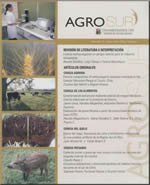TAU FLUVALINATE RESIDUES (PYRETHROID) IN THE WAX OF THE BROOD CHAMBER AND ITS EFFECT ON LARVAE OF WORKER CASTE BEES (Apis mellifera L.)
Main Article Content
Abstract
Since the application of tau fluvalinate to control Varroa destructor Anderson & Trueman negatively affects larvae of A. mellifera, an study was carried out to measure the damage caused by the residual presence of the chemical in the beeswax of the breeding chamber in the development of working bees larvae. First, third and fifth instars larvae were studied using three treatments (concentrations of 8, 12 and 18 ppm of the chemical) and a control (0 ppm) in Langstroth hives waxes located at the Austral University of Chile facilities (Los Ríos region). Every fifth frame of the breeding chamber was replaced with a treated one. The parameters used for evaluation where weight, size, color, scent, mortality and the final concentration of fluvalinate in beeswax. It was determined that tau fluvalinate affects the normal larval development regarding weight and size in the three stages; in both cases the fifth stage was more affected with the concentration of 18 ppm, showing less than 17.8% of the normal weight and less than 12.2% of the normal size. The color, odor and mortality of the larvae were not affected by the chemical in any of the concentrations used, therefore the LD50 of this product, for working bees, is higher than 18 ppm.. The concentration of tau fluvalinate in the wax decreased in 93% which could be caused by the dilution of the product due to wax stretching.

